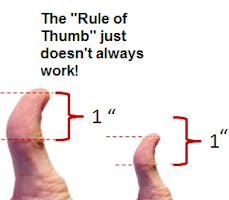
|
Some Common Myths Thought to be True - Myth 30
Myth 30: Rule of Thumb Origin from "Beating Your Wife"
A rule of thumb is a principle with broad application that is not intended to
be strictly accurate or reliable for every situation. It is an easily learned
and easily applied procedure for approximately calculating or recalling some
value, or for making some determination.
|
| Rule of Thumb | |
|
Another possible origin of the phrase comes from measurement, in particular in
agricultural fields. The plants need a fairly precise depth to seed properly,
whether planted from seed or being replanted, but the depth can sometimes be
estimated using the thumb. That is, a rule "(measurement) of thumb". According
to Gary Martin, "The origin of the phrase remains unknown. It is likely that it
refers to one of the numerous ways that thumbs have been used to estimate
things - judging the alignment or distance of an object by holding the thumb in
one's eye-line, the temperature of brews of beer, measurement of an inch from
the joint to the nail to the tip, or across the thumb, etc. The phrase joins
the whole nine yards as one that probably derives from some form of measurement
but which is unlikely ever to be definitively pinned down."
|
|
| ⇦ Back to Myth 29 Return to Myth Choices Page 2 On to Myth 31 ⇨ | |